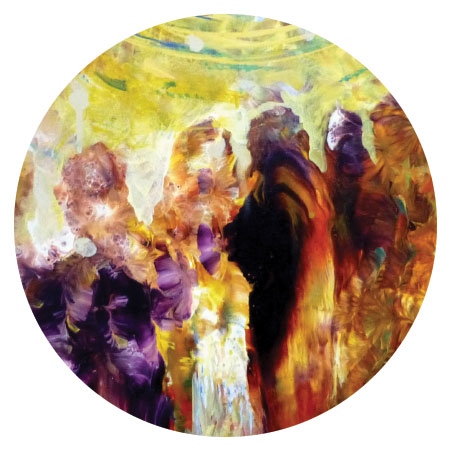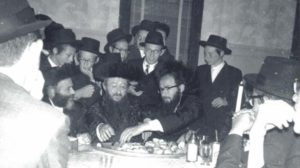Turnabout

The Megillah is our reference point for all the unanswered questions riddling our path toward Geulah
O

ne of the most original Purim costumes I ever encountered was the “upside-down boy.” This creative young man wore a shirt instead of pants, his legs squeezed through the armholes, and placed gloves on his feet. He wore pants over his arms and raised them high above his head, his hands adorned with sneakers to complete the look.
Everywhere the upside-down boy went, he went elicited shrieks of delight: “Look! He’s walking on his hands! He’s upside down!” The only drawback of this extraordinarily original costume was the unfortunate detail of his arms; to preserve the “upside-down” effect, he had to hold them above his head all Purim-day long. Ouch.
During our requisite 800 trips across the neighborhood to deliver mishloach manos to every person we had ever known (this gilgul and the last), I crossed paths with the upside-down boy numerous times. (And yes, I caught him with his hands down more than once.)
Chain of Reversals
Truthfully, the upside-down boy is a perfect Purim costume. “V’nahafoch hu,” the turnabout, is one of the major themes of Purim.
The Purim miracle is one long chain of stunning reversals: The mighty Queen Vashti, heiress to the vast Persian kingdom, is inexplicably cut down in a moment of drunken rage. Haman, prominent advisor to the king, is appointed footman to his nemesis, Mordechai, in a grand parade; he is shortly thereafter summarily booted from the king’s private feast and hanged from his self-constructed gallows. The Megillah climaxes with the Jews turning on their adversaries, slaying their would-be murderers. Perek after perek, we observe the silent Hand of Hashem inverting wickedness for Klal Yisrael’s gain.
The idea that things can be favorably reversed at any moment complements the general atmosphere of cheerfulness and joy we associate with this day. But why is the message of v’nahafoch hu worthy of its own holiday? All of Hashem’s miraculous interventions contain some element of turnabout; the very nature of miracles is to overturn the course of natural events. What does the v’nahafoch hu of Purim add?
Eternal Message
Talmud Yerushalmi (Megillah, perek 1) raises an even more fundamental question: Rabi Yochanan teaches that with the coming of Mashiach, all the books of Neviim and Kesuvim will be eliminated. Rabi Shimon ben Levi clarifies that Megillas Esther and its halachos will not be eradicated — they will endure.
What would motivate us to excise 18 of our 24 holy books? Does Mashiach’s arrival suddenly render them irrelevant? Rav Chaim Friedlander (Sifsei Chaim) explains that during the era of Mashiach, the revelation and recognition of Hashem’s existence will be of such magnitude, it will simply dwarf the revelations from the times of the neviim. Similarly, Berachos (12b) contends that when Mashiach comes and gathers the exiles, the utterances that spoke of Hashem’s greatness for redeeming us from Mitzrayim will be replaced with praise for liberating us from our present galus. Like a candle by day, the miracles of Mitzrayim will be infinitely less significant when compared with the blinding luminosity of Mashiach.
Yet somehow, even with the burning clarity generated by Mashiach’s arrival, the message of Purim will still maintain its relevance. Why won’t its message be subsumed like the rest of our sifrei Nach? How will the Purim miracle emanate from behind the glow of a thousand suns?
What constitutes a great miracle? Some miracles, like Kri’as Yam Suf, the collapsing walls of Yericho, and reviving the Ishah HaShunamis’s lifeless son, are distinguished by how they utterly contravene the natural order of the world. We are left breathless when nature, under the direction of Hashem, responds in the most incoherent, illogical fashion.
But what of less obvious miracles, the ones that float gently beneath the borderline of our perception, where we have to sift and squint to sense that, indeed, something astonishing has unfolded? What of the miracles that playfully dart beneath our threshold of awareness, impishly daring us to take notice?
Hidden Miracles
At first glance, we might say that unconcealed miracles are a superior manifestation of Hashem’s governance over His world. After all, what can compare to witnessing our otherwise trustworthy natural world reconfigure itself in response to Hashem’s Will? However, the Maharal (Gevuros Hashem) ranks overt miracles as the lesser of the two types.
During the Sheishes Yemei Bereishis, Hashem inaugurated a firm system of natural laws to govern the world, with provisions for all potential aberrations. When Hashem employs open miracles, He subverts the system He established. This may give the impression that Sheishes Yemei Bereishis did not anticipate every potential anomaly, and that its laws are unequipped to deal with every situation in a linear fashion. Instead, Hashem must overcome and defeat His preordained system to satisfy the demands of the moment. Thus, instead of an open miracle articulating the wisdom of Creation, it can potentially express the exact opposite, chas v’shalom! (The Maharal clarifies that even the deviations from natural law — expressed as overt miracles — are in fact encoded in Creation and were anticipated from the world’s inception.)
Hidden miracles are woven in to the prosaic, unremarkable tempo of life. Events seem to unfold of their own organic accord, people behaving and responding as we would expect, with nary an indication that this is anything other than business as usual. But in fact, Hashem is subtly lacing together the reaction of one with the desires of another, weaving one person’s ambitions with another’s apathy, until the intertwined whole is precisely what He desires.
Hidden miracles are magnificent because Hashem achieves His outcome not by subverting nature or suppressing free will, but from within the autonomous choices and decisions people make. While mankind maintains its sovereign role, it serves as an unwitting catalyst for the realization of Hashem’s Will.
Thus, while Achashveirosh chose to murder his wife Vashti, he was in fact pouring the foundation for Esther’s pivotal ascent. And when Haman gleefully constructed the gallows for Mordechai, he was inadvertently inching himself closer to his own demise. This is the synchronized beauty of hidden miracles, and the poetic justice we so appreciate in v’nahafoch hu.
At the Helm
Why do we yearn for Mashiach? Some people long to see Hashem revealed as the ultimate King over the world. Others desire techiyas hameisim, when they will be reunited with their loved ones. Still others crave answers to the unanswerable: Why is there tragedy? Why do people suffer? Why the Holocaust, the Iron Curtain, Arab bloodlust?
Daas Tevunos teaches that at times Hashem consigns the world to its own devices, to run wild as if unchecked. Evil, unhindered by Hashem’s constraints, invades the smallest spaces, charging humanity toward complete systemic demise. At Mashiach’s arrival, when goodness and virtue seem most utterly defeated, He reveals Himself, and in one fluid motion, rotates the evil to a dramatic reversal. Now, not only do we see how He was indeed at the helm the entire time, but the turnabout retroactively illuminates the supposed evil, recasting it as good.
Imagine standing outside the closed door of a hospital room, listening as an obviously anguished person cries in pain. You are about to barge into the room and rescue this suffering patient when another sound from the room abruptly changes everything… it is the thin wail of a newborn child.
The v’nahafoch hu of the Purim story is a microcosm of the turnabout we will perceive in Yemos HaMashiach. As we read the Megillah, we reflect on how easy it is to miss Hashem’s veiled Presence, to be caught up in the unmitigated power of an evil king and his viceroy, to be distracted by a sky-high gallows and a royally signed decree. And we realize that we are equally distracted by a hostile Arab demographic, surging anti-Semitism, countless kids hemorrhaging from Torah observance.
The Megillah is our touchstone, our reference point for all the unanswered questions riddling our path toward Geulah; it is the portrait of the laboring woman, moments before birth. Purim reminds us that precisely what seems to be the harbinger of defeat will eventually be revealed as Hashem’s silent Hand deftly manipulating events for our stunning triumph.
And it will endure long past the triumphant end to our exile because it is our prototype in galus for the stunning reversals we will see at Geulah; it is the closest we can get to the culture of redemption while still mired in exile.
An Upside-Down World
The v’nahafoch hu of Purim is reminiscent of another turnaround recorded in the Torah (Bava Basra 10b): Rav Yosef, son of Rabi Yehoshua, fell ill and died.
Subsequently he was revived, and his father asked, “What did you see in the Next World?”
His son replied, “I saw an upside-down world. The people who are elyonim (uppermost) in This World were tachtonim (lowest) in the Next World. Those who are tachtonim in This World were elyonim in the Next World.”
His father responded, “You have seen a coherent world.”
When taken at face value, many aspects of This World are misleading. People in the uppermost strata of society are venerated, often in spite of their lack of moral rectitude. The less fortunate, those without claim to fame or prosperity, spend life marginalized despite their outstanding moral caliber. As Torah-observant Jews, we presume ourselves to be beyond this pretense, able see past the magnetic appeal of externals.
Rabi Yehoshua and his son Yosef teach us otherwise; we too mistake the elyonim for tachtonim. Rashi explains that the example of elyonim refers to people who are revered in This World for their wealth; in the Next World, they sink to the bottom. And tachtonim, the ones who are scorned (or at best impatiently tolerated) in This World for their indigence, inhabit the upper echelons of the Next World. In a moment of utter honesty, how do we regard the “have nots” of the world? The ones who despite effort and toil have simply never “made it” by the standards of our society? Do we secretly view them as elyonim or tachtonim?
Rabi Yehoshua teaches that in the Next World, the world of truth, Hashem performs a v’nahafoch hu, flipping This World’s distorted metric in order to honor those who were capriciously denied esteem in This World. Perhaps this is one way to understand the mitzvah of matanos l’evyonim: On the Yom Tov most indicative of turnabout we are reminded that in the World to Come the evyonim will be subject to a dramatic reversal as well.
Rabi Yehoshua’s upside-down world extends beyond poverty and prosperity. What of the people in This World who were not invested with outstanding talents and abilities, but are simply abiding their quiet lives, trying their best to please their Borei? They will never be tapped to spearhead a Torah initiative, head a frum institution, or deliver a world-class shiur. They are neither glamorous nor prestigious, slipping unceremoniously under the radar in pursuit of their private spiritual goals. In This World they are tachtonim, unlettered Jews — but in the world of v’nahafoch hu they will be celebrated as elyonim.
On Purim we go incognito, donning costumes that obscure the image we present year-round. In a sense, our costumed selves are restitution for the mistake of pretense: From behind his mask, the simple shopkeeper is indiscernible from the shul president, the talented maggid shiur indistinguishable from the fresh returnee. Without the familiar markers of status and prestige, we are reminded that only Hashem, Who perceives the heart of man, can determine who elyonim are and who are tachtonim. In a sense, at this juncture of epic v’nahafoch hu, we have succeeded in briefly reinstating the “coherent world” of Rabi Yehoshua.
This Purim, may we merit a total v’nahafoch hu: for the turnabout that was then and the dramatic reversals we have yet to see, in This World and the Next.
Mrs. Elana Moskowitz has been teaching in seminaries for nearly 20 years.
(Originally featured in Family First, Issue 683)
Oops! We could not locate your form.











